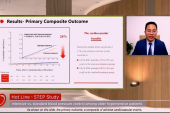Balancing Hypertension and Fall Risk: A Delicate Dance in Elderly Patients
The study of VA patients suggests that starting a new BP drug increases the risk of falls and fractures, likely due to hypotension.

Caution is needed in balancing the risk of falls and fractures with the need to lower blood pressure for elderly patients living in long-term care facilities, data from the Veterans Health Administration show.
In the propensity-matched analysis, older individuals starting on a new antihypertensive medication were more than twofold likely to suffer a fracture within the first 30 days than those who did not, report Chintan V. Dave, PharmD, PhD (Rutgers The State University of New Jersey, New Brunswick), and colleagues in JAMA Internal Medicine.
“The risk was highest in the 30-day period, but it starts attenuating over time [and] is still significant at day 90,” Dave told TCTMD. “So, despite the attenuation, it’s still a 70% increased risk over 90 days, which is a lot.”
The study also found that patients with dementia were at particularly high risk for a fracture.
In considering the consequences of falls that occur in this population despite the vigilance of staff and prevention measures like guardrails, Dave noted to TCTMD that hip fractures alone have been linked to 1-year mortality rates exceeding 40% in nursing home patients.
“Hip fractures are devastating in general, but nursing home patients especially are already a very vulnerable population,” he added.
In an accompanying editorial, Muna Thalji Canales, MD, and Ronald I. Shorr, MD (both from Malcom Randall VA Medical Center, Gainesville, FL), say the data “create a compelling narrative” that lowering BP too rapidly may induce hypotension, predisposing elderly adults to falls that can lead to serious injury.
They say the data also extend results from a secondary analysis of the SPRINT trial that suggested intensive lowering of systolic BP to less than 120 mm Hg is associated with an increased risk for orthostatic hypotension, and possibly syncope.
A key question that Canales and Shorr say the new findings raise is whether the “unrealistic goal of no falls” should come at the expense of treating hypertension in patients living in long-term care homes.
“Beyond race, ethnicity, sex, and socioeconomic status, older nursing home residents are a heterogeneous, complex population in which we, as healthcare practitioners, should feel good about tailoring therapy to meet the individual patient’s healthcare priorities and circumstances,” they write.
Since no two octogenarians are alike, they suggest using prognostic calculators like ePrognosis and gauging hypotension risk, with the option to accept a higher BP in exchange for avoiding hypotension that could lead to a fall.
Dementia Amplifies Fracture Risk
Dave and colleagues analyzed data from 64,710 propensity score-matched long-term care nursing home residents (mean age 78 years; 2% women) from Veterans Health Administration facilities. Compared with controls not initiating antihypertensives, those who did start the drugs had higher systolic and diastolic blood pressures, were more likely to be diagnosed with heart failure or MI, and were more often prescribed opioids and benzodiazepines. One-quarter of initiation and control patients had a recent fall, with more than 60% in each group having some history of falls. Dementia was present at baseline in 55% of all patients.
At 30 days, the fracture rate for those on a new antihypertensive drug was 5.4 per 100 person-years compared with 2.2 in the control groups (adjusted HR 2.42; 95% CI 1.43-4.08). Fractures included nontraumatic pelvic fracture, surgically treated hip fracture, and fractures of the humerus, radius, or ulna requiring intervention.
Patients on new antihypertensives also had a higher risk of serious falls requiring hospitalizations or visits to the emergency department compared with controls (HR 1.80; 95% CI 1.52-2.13) and a greater likelihood of syncope (HR 1.69; 95% CI 1.30-2.19).
In subgroup analyses, factors associated with an even greater risk of fracture after starting a new antihypertensive included dementia (HR 3.28; 95% CI 1.76-6.10), systolic BP of 140 mm Hg or higher (HR 3.12; 95% CI 1.71-5.69), diastolic BP of 80 mm Hg or higher (HR 4.41; 95% CI 1.67-11.68), and no recent prior use of an antihypertensive (HR 4.77; 95%CI 1.49-15.32).
Antihypertensives as a Modifiable Risk Factor
In their paper, the investigators say antihypertensive medications may represent a prominent modifiable risk factor for fall prevention in this population.
While dementia is in some ways an easier to grasp risk factor due to underreporting or lack of understanding of symptoms by patients, Dave said the increased risk of fractures at higher systolic or diastolic levels requires a more-nuanced interpretation.
“If you start off with lower blood pressure to begin with, you don't have a lot of room to go down. But, with higher blood pressure, you actually have a higher propensity for orthostasis. It is a little counterintuitive, but it does make sense,” he added.
In terms of understanding how antihypertensive medications work in the elderly, that too can be unclear, Dave said, since patients in long-term care facilities have largely been excluded from trials of many agents. “We don't know if these drugs work as well in this patient population,” he noted. “We can still translate some benefit . . . but you also have to balance that against being especially predisposed to some adverse reactions like falls and fractures.”
Canales and Shorr note that an additional factor that needs to be taken into account in this patient population is how they feel on antihypertensives.
“Some nursing home residents simply do not feel good with tight control of blood pressure, and feeling good may be what is most important to that resident,” they write. “Discussion with the patient and their loved ones regarding goals of care can help guide the approach to blood pressure management in nursing homes.”
L.A. McKeown is a Senior Medical Journalist for TCTMD, the Section Editor of CV Team Forum, and Senior Medical…
Read Full BioSources
Dave CV, Li Y, Steinman MA, et al. Antihypertensive medication and fracture risk in older Veterans Health Administration nursing home residents. JAMA Intern Med. 2024;Epub ahead of print.
Canales MT, Shorr RI. Blood pressure management and falls in nursing home residents—a matter of balance. JAMA Intern Med. 2024;Epub ahead of print.
Disclosures
- Dave reports no relevant conflicts of interest.
- Canales reports receiving a grant from Veterans Health Administration Health Services Research and Development.
- Shorr reports receiving grants from the National Institutes of Health and having provided expert testimony regarding falls in hospitals and nursing homes.





Comments